
Power transmission and fluid power solutions provider Gates Corporation (NYSE:GTES) reported revenue ahead of Wall Street’s expectations in Q1 CY2025, but sales fell by 1.7% year on year to $847.6 million. Its non-GAAP profit of $0.36 per share was 9.2% above analysts’ consensus estimates.
Is now the time to buy Gates Industrial Corporation? Find out by accessing our full research report, it’s free.
Gates Industrial Corporation (GTES) Q1 CY2025 Highlights:
- Revenue: $847.6 million vs analyst estimates of $823.4 million (1.7% year-on-year decline, 2.9% beat)
- Adjusted EPS: $0.36 vs analyst estimates of $0.33 (9.2% beat)
- Adjusted EBITDA: $187.3 million vs analyst estimates of $180.9 million (22.1% margin, 3.5% beat)
- Management reiterated its full-year Adjusted EPS guidance of $1.44 at the midpoint
- EBITDA guidance for the full year is $765 million at the midpoint, above analyst estimates of $757.8 million
- Operating Margin: 14.7%, up from 13.5% in the same quarter last year
- Free Cash Flow was -$10.2 million compared to -$39.1 million in the same quarter last year
- Organic Revenue rose 1.4% year on year (-3.6% in the same quarter last year)
- Market Capitalization: $4.63 billion
Ivo Jurek, Gates Industrial's Chief Executive Officer, commented, "In the first quarter, we grew our volume company-wide supported by strong growth in our Auto Replacement and Personal Mobility end markets. Also, our gross margin increased nicely year-over-year."
Company Overview
Helping create one of the most memorable moments for the iconic “Jurassic Park” film, Gates (NYSE:GTES) offers power transmission and fluid transfer equipment for various industries.
Sales Growth
Examining a company’s long-term performance can provide clues about its quality. Any business can put up a good quarter or two, but the best consistently grow over the long haul. Over the last five years, Gates Industrial Corporation grew its sales at a sluggish 2.5% compounded annual growth rate. This fell short of our benchmarks and is a rough starting point for our analysis.
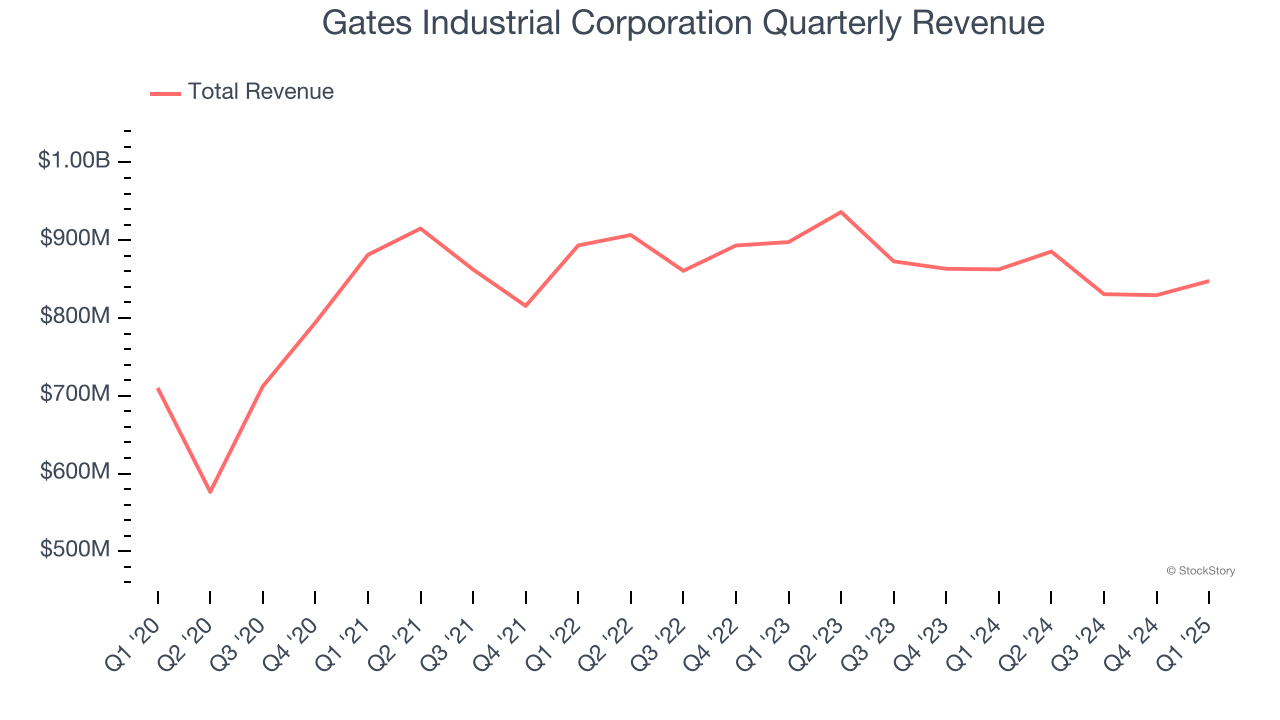
We at StockStory place the most emphasis on long-term growth, but within industrials, a half-decade historical view may miss cycles, industry trends, or a company capitalizing on catalysts such as a new contract win or a successful product line. Gates Industrial Corporation’s performance shows it grew in the past but relinquished its gains over the last two years, as its revenue fell by 2.4% annually. 
Gates Industrial Corporation also reports organic revenue, which strips out one-time events like acquisitions and currency fluctuations that don’t accurately reflect its fundamentals. Over the last two years, Gates Industrial Corporation’s organic revenue averaged 1.7% year-on-year declines. Because this number aligns with its normal revenue growth, we can see the company’s core operations (not acquisitions and divestitures) drove most of its results. 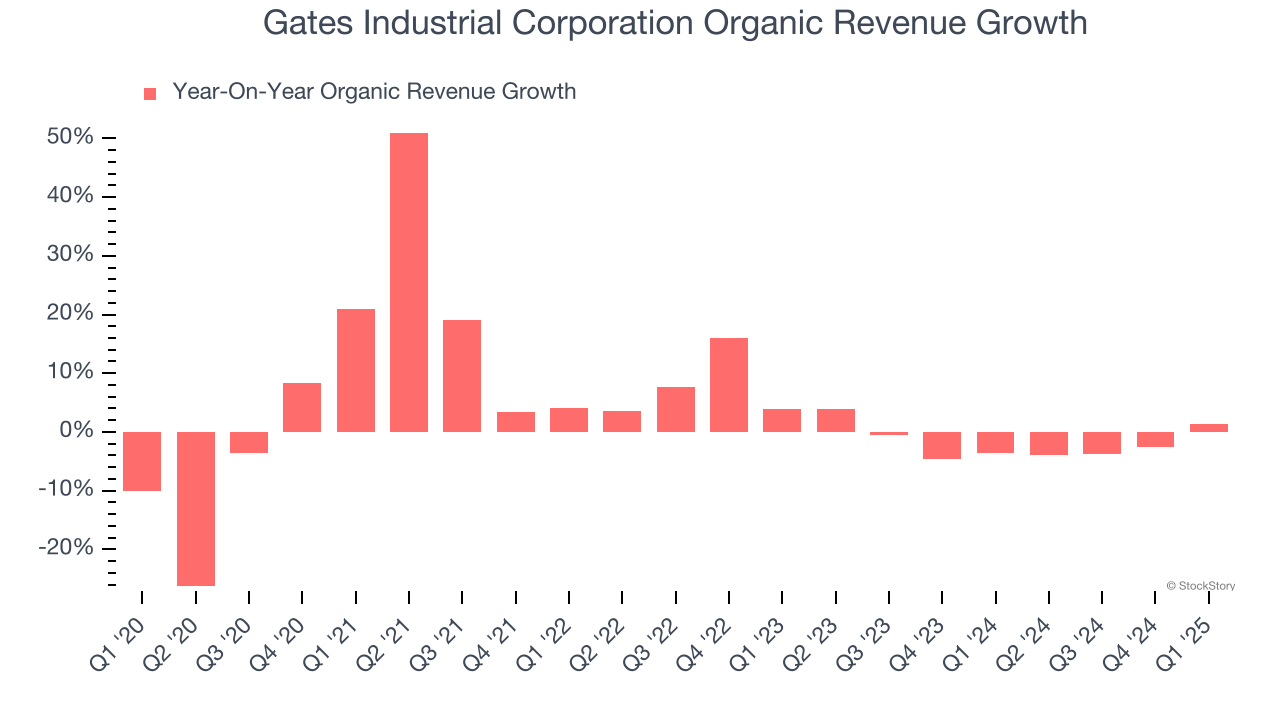
This quarter, Gates Industrial Corporation’s revenue fell by 1.7% year on year to $847.6 million but beat Wall Street’s estimates by 2.9%.
Looking ahead, sell-side analysts expect revenue to remain flat over the next 12 months. Although this projection suggests its newer products and services will spur better top-line performance, it is still below the sector average.
Here at StockStory, we certainly understand the potential of thematic investing. Diverse winners from Microsoft (MSFT) to Alphabet (GOOG), Coca-Cola (KO) to Monster Beverage (MNST) could all have been identified as promising growth stories with a megatrend driving the growth. So, in that spirit, we’ve identified a relatively under-the-radar profitable growth stock benefiting from the rise of AI, available to you FREE via this link.
Operating Margin
Gates Industrial Corporation has been an efficient company over the last five years. It was one of the more profitable businesses in the industrials sector, boasting an average operating margin of 12.3%. This result isn’t surprising as its high gross margin gives it a favorable starting point.
Analyzing the trend in its profitability, Gates Industrial Corporation’s operating margin rose by 4.9 percentage points over the last five years, as its sales growth gave it operating leverage.
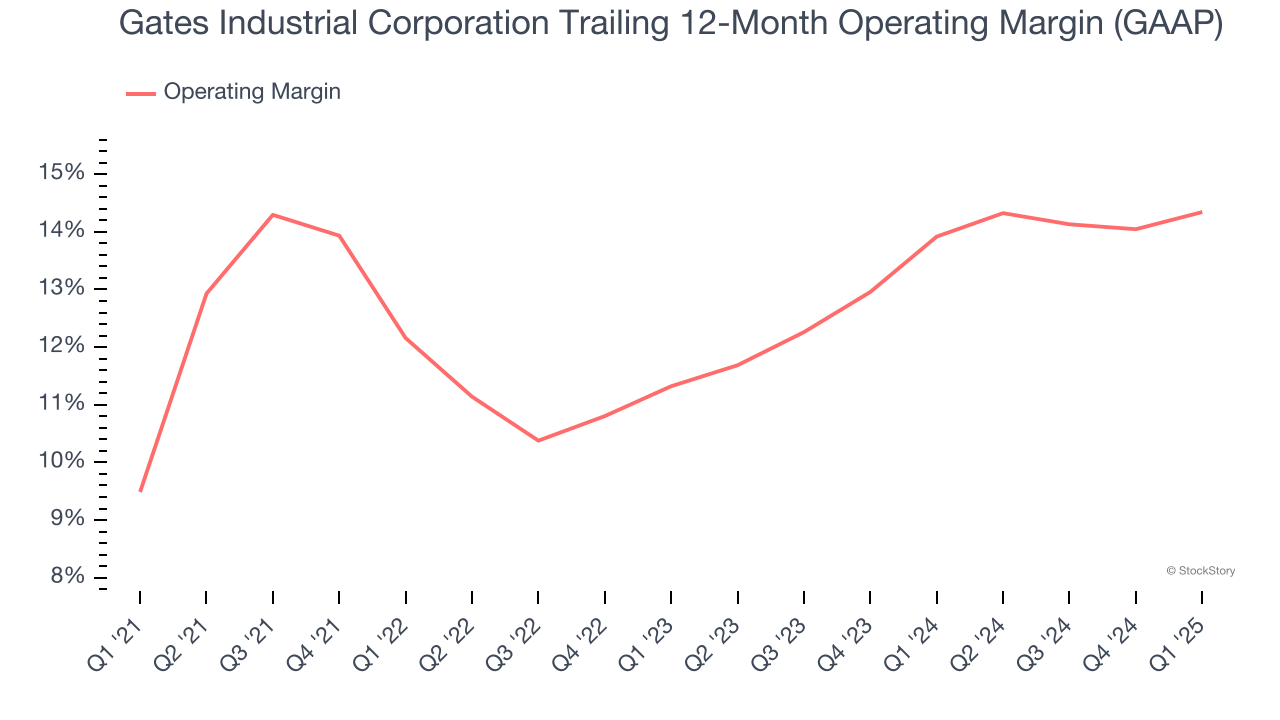
In Q1, Gates Industrial Corporation generated an operating profit margin of 14.7%, up 1.2 percentage points year on year. Since its gross margin expanded more than its operating margin, we can infer that leverage on its cost of sales was the primary driver behind the recently higher efficiency.
Earnings Per Share
We track the long-term change in earnings per share (EPS) for the same reason as long-term revenue growth. Compared to revenue, however, EPS highlights whether a company’s growth is profitable.
Gates Industrial Corporation’s EPS grew at a decent 9.7% compounded annual growth rate over the last five years, higher than its 2.5% annualized revenue growth. This tells us the company became more profitable on a per-share basis as it expanded.
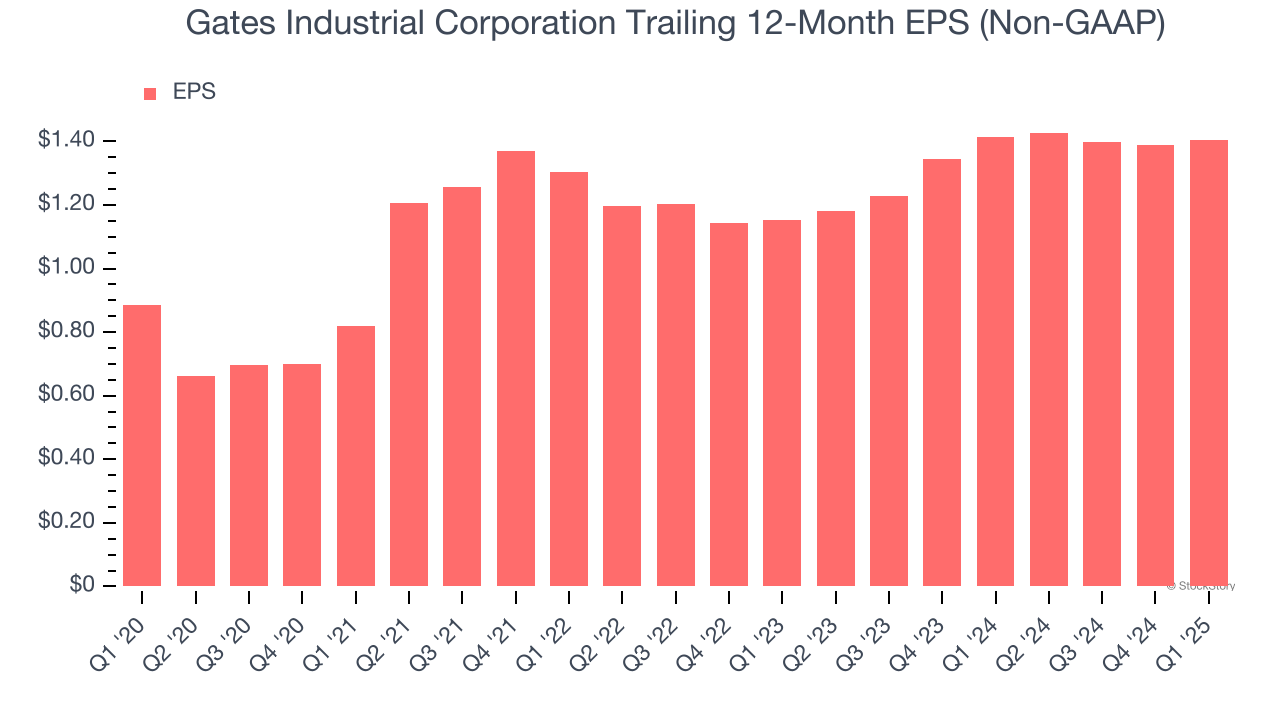
Diving into the nuances of Gates Industrial Corporation’s earnings can give us a better understanding of its performance. As we mentioned earlier, Gates Industrial Corporation’s operating margin expanded by 4.9 percentage points over the last five years. On top of that, its share count shrank by 12.6%. These are positive signs for shareholders because improving profitability and share buybacks turbocharge EPS growth relative to revenue growth. 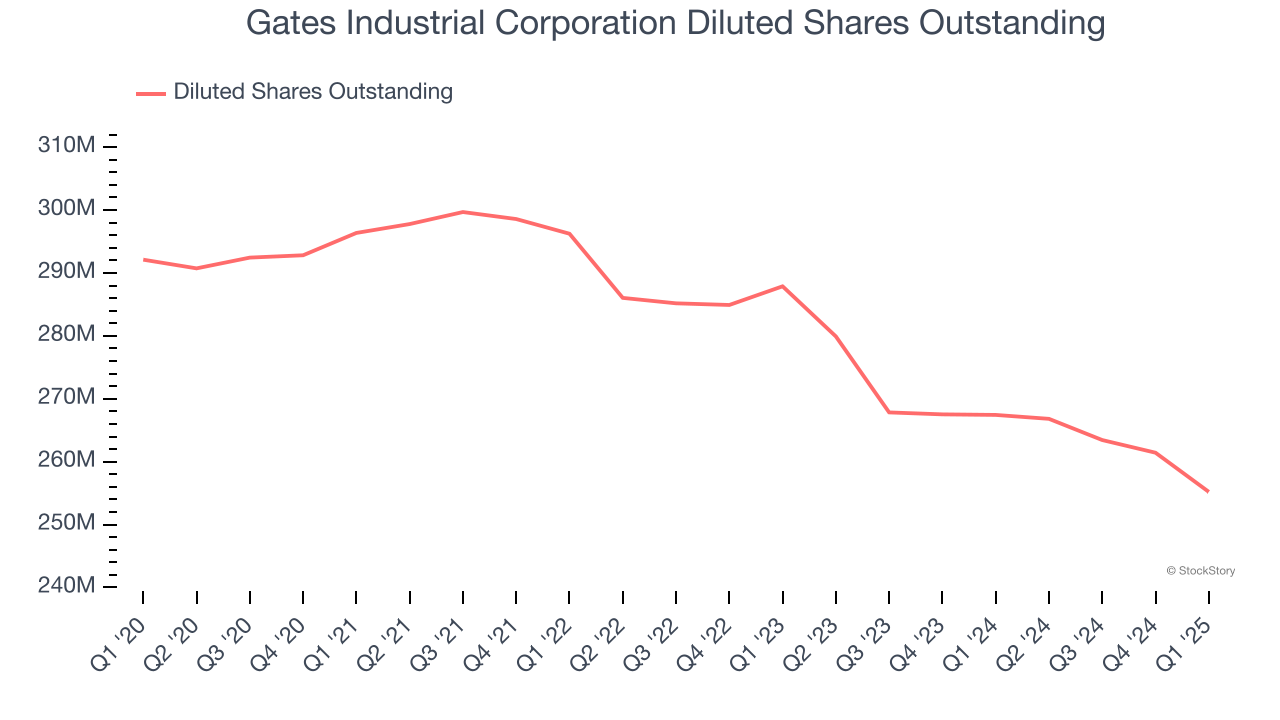
Like with revenue, we analyze EPS over a more recent period because it can provide insight into an emerging theme or development for the business.
For Gates Industrial Corporation, its two-year annual EPS growth of 10.4% is similar to its five-year trend, implying stable earnings power.
In Q1, Gates Industrial Corporation reported EPS at $0.36, up from $0.34 in the same quarter last year. This print beat analysts’ estimates by 9.2%. Over the next 12 months, Wall Street expects Gates Industrial Corporation’s full-year EPS of $1.41 to grow 3.7%.
Key Takeaways from Gates Industrial Corporation’s Q1 Results
We enjoyed seeing Gates Industrial Corporation beat analysts’ organic revenue, EPS, and EBITDA expectations this quarter. We were also glad its full-year EBITDA guidance topped Wall Street’s estimates. Zooming out, we think this was a good quarter with some key areas of upside. The stock traded up 3% to $18.45 immediately following the results.
Gates Industrial Corporation may have had a good quarter, but does that mean you should invest right now? The latest quarter does matter, but not nearly as much as longer-term fundamentals and valuation, when deciding if the stock is a buy. We cover that in our actionable full research report which you can read here, it’s free.
